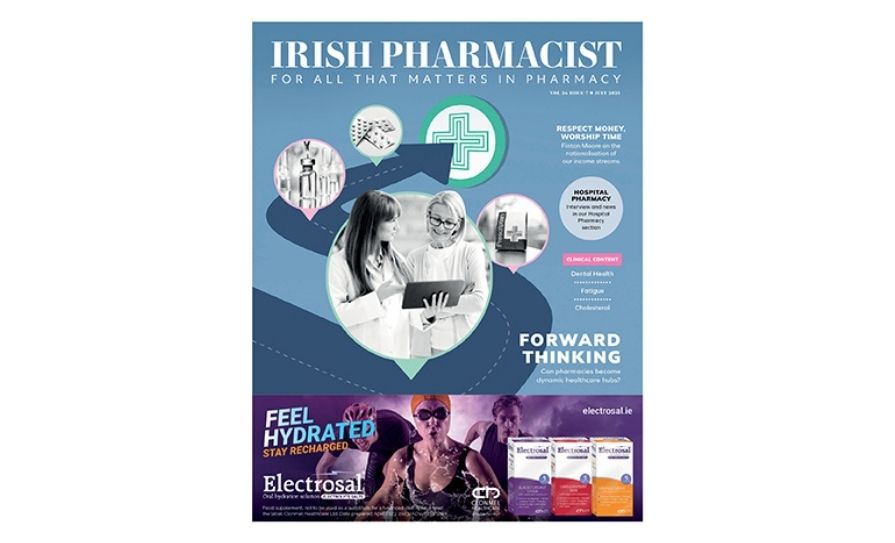The pharmacy profession needs to do its part in staying vigilant against the rising tide of codeine misuse, writes Dr Des Corriga
A number of recent papers from the Royal College of Surgeons in Ireland (RCSI), the School of Health Sciences at Waterford Institute of Technology (WIT) and from a pharmacist currently studying medicine at the University of Limerick, have all shone a spotlight on the misuse and abuse of codeine-containing analgesics in Ireland and on the profession’s response to this issue.
First, the good news. The RCSI group, drawn from the Department of Geriatrics and Stroke Medicine, the Population Health Sciences Division and the National Poisons Information Centre (NPIC) at Beaumont Hospital, pointed out in a 2019 paper in the journal Pharmacoepidemiology and Drug Safety the challenge in accurately quantifying the actual extent of opioid, especially codeine, misuse in Ireland. They studied data on codeine-related poisonings from the NPIC for the years 2005 to 2016. They found that there was a 53 per cent reduction in poisonings involving both prescribed and OTC codeine between 2005 and 2016. They then looked specifically at data for 2010 and 2011 after the PSI had issued guidelines relating to OTC supply of codeine-containing products. There was a 62 per cent reduction in cases involving OTC codeine between 2005 and 2016, with a 33 per cent decrease between 2010 and 2011. Obviously, this is a really significant effect that supports the often-criticised approach by the regulator. The researchers also looked at the PCRS data on prescribed low-dose paracetamol/codeine preparations and these did not show any increase over the years in question. There was also no evident increase in the prescribing of more potent opioids in response to the restricted availability of the OTC brands.
Disappointingly, the rate of decline was not maintained, as there was minimal change between 2012 and 2016, with an increase reported for 2013.
I was surprised to learn that 55 per cent of the cases of codeine poisoning were intentional because most of the discourse on codeine has centred on its addictive properties as an explanation for excessive use. The next-most frequent cause of poisoning was accidental, at 27 per cent, followed by therapeutic error in 15 per cent of cases. The authors highlighted that they could not include all cases of poisoning in their calculations because cases occurring between 10pm and 8am are referred to the UK National Poisons Information System because the Beaumont centre is closed during those hours. In addition, they point out that the poisoning rates do not capture chronic abuse/misuse of codeine-based analgesics.
The less-positive news comes from a series of papers from the School of Health Sciences at WIT based on work by the highly prolific researcher Dr Marie Claire Van Hout. In a 2018 report published in Substance Abuse Treatment, Prevention, Policy, she and her collaborators describe the results of a survey of pharmacy staff in the UK, South Africa and Ireland. The biggest number of participants came from Ireland (464) because the PSI assisted in circulating the survey instrument. Overall, pharmacists from all three countries viewed codeine misuse as a problem in their patients. Only 39 per cent of Irish staff reported the availability of a risk management system for codeine products, compared to over 50 per cent in the other two countries. Nearly three-quarters expressed a willingness to participate in a centralised monitoring system covering the supply of codeine products. Nearly 60 per cent of pharmacy staff in Ireland believe that current controls are insufficient but they do not seem to have been asked for their views on making codeine prescription-only, as is the case in Australia, Austria and Italy. The provision of education and support materials for patients was supported by 85 per cent of respondents. Surprisingly, only 15 per cent of pharmacists in Ireland reported that they had received any kind of specialist training in substance abuse issues, with 62 per cent of Irish participants indicating their need for further training and education. My surprise relates to the fact that the Trinity degree course has had a detailed segment on drug abuse and addiction for many years, including a specific Addiction Pharmacy module in more recent times.
The main gap admitted to by participants related to information and training on how to identify and address codeine misuse. What follows is an attempt to respond to those gaps. Signs to look out for include repeated requests for products by name; refusal by patients to consider single-ingredient paracetamol or ibuprofen products; and agitation at pharmacist/pharmacy staff interventions. Physical symptoms that might indicate misuse would include complaints about headache (‘medication overuse headache’) or constipation. Serious side-effects such as paracetamol hepatotoxicity or gastrointestinal haemorrhage are more likely to be picked up by primary or secondary care services. There is, though, a case for referral by pharmacists to the latter services resulting from sensitive exploration in private of a patient’s analgesic use, possibly following a medication utilisation review that included codeine. Another possibility suggested by Dr Van Hout and colleagues involves the inclusion of a self-screening leaflet with each purchase, along with an invitation for a follow-up discussion with a pharmacist.
Such a screen could be based on the well-known Drug Abuse Screening Test (DAST), a 10- item instrument that includes questions such as: Have you used codeine other than for medical reasons? Are you always able to stop using codeine when you want to? Have you experienced withdrawal symptoms when you stopped codeine? Do you ever feel bad or guilty about your codeine use? Scores of three or more indicate moderate-to-severe levels of misuse for which referral to specialist services is indicated.
Such a service is provided at the St John of God Hospital in Stillorgan under the leadership of consultant psychiatrist Dr Colin O’Gara. He is on record as having stated that some patients will need no intervention as they realise that immediate withdrawal (‘cold turkey’) is the most time efficient option for them. Many others will require managed withdrawal on an inpatient basis because patients may have continued easy access to codeine preparations in a community setting. Some may detox without the support of medication such as sedatives but others may need opioid maintenance therapy (OMT) involving either methadone or buprenorphine. OMT may be necessary in the most severe cases where patients may have been using up to one gram of codeine per day. Lofexidine may also be used to alleviate any noradrenergic surge associated with the withdrawal process. The rehabilitation programme that follows on from the detox may last from one-to-three months with intensive group and individual therapy. This is based on Cognitive Behavioural Therapy (CBT) challenging negative self-defeating thoughts that maintain the addiction.
Given how disruptive to an individual’s life such an intervention is likely to be, surely the old cliché about prevention being better than cure comes into play. Continued vigilance, advice and patient education in the pharmacy about codeine is essential.







